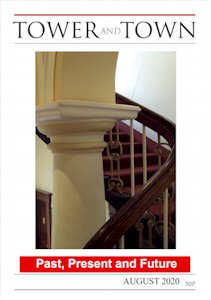

Tower and Town, August 2020 (view the full edition) (view the full edition)An Oak Is An Oak - Or NotHow quintessentially English is the oak! Regardless of the great elms and pines essential in building the Victory, the Mary Rose, the Golden Hind, it is the oak we cherish as the timber that defended our nation in sea-borne conflicts of old. It is so deep within our psyche it would not be amiss centred on the England flag, and though Savernake Forest contains many mighty trees, only the oaks are deemed worthy of naming... however they are not as 'English' as one might expect. When I first explored Savernake I visited the named oaks and was intrigued by one called Cluster Oak. It had no name plate so I looked for something grand like Ayers Oak or an ancient remnant like Big Belly - but there was nothing, just a small cluster of respectable trees that I assumed was a cluster of oaks, but I was wrong. A Cluster Oak is a particular subspecies on which the leaves grow in dense twisted clusters, and yes, our Cluster Oak does exist - a rather small, sad specimen now boasting its name board. The King Oak was the same species and the Replacement King, another poor specimen, was grown from one of the old King's acorns. The whole species was first discovered in 1917 in, yes, Savernake. I was also wrong about Turkey Oak, not named after a Christmas dinner but the common name of a tree that comes from Turkey. It is perhaps the finest looking of our oaks and identified by its bristly acorn cups, but the timber shatters too easily for construction purposes. The oak that we like to think made our 'men o' war' is the Common or English Oak also known as the Pedunculate Oak because its acorns grow on long stalks or peduncles, however it is not so common as one might imagine in Savernake. Of the twenty-six named trees only Cathedral Oak is pure English. The other supposedly common oak is the Durmast or Sessile Oak with its acorns sessile or closely seated on the twigs and only five of these trees have been named in Savernake. So what of the other seventeen named oaks? All are hybrids of the English and Durmast and oddly, though very common, have no common name. The scientific name is Quercus (Latin for oak) x (meaning hybrid) rosacea (made of roses - though it's not, nor is it red!). Even Big Belly is such a hybrid. And to further confuse, there are also some American oaks. If six local species seems too daunting, consider the fifty plus species in Europe alone! Even so, the Oak is our tree and we love it. Peter Noble |